Twitter Hashtag Research

Like so many people, you probably want to find the best Twitter hashtags to help your Tweets be seen. There are, of course, many different websites that track the latest Twitter hashtag trends that show what people are talking about. However, the questions remain relating to what types of hashtags will benefit you or your business the most. Many times, it is not just choosing the trending hashtags for your posts, especially if those hashtags are not relevant.
In this article, we will highlight how to do Twitter hashtag research and analysis with a social media tool so that you can find out what the best Twitter hashtags are to use with your Tweets. While there are only a few steps to follow, Twitter hashtag research results in enormous benefits that exceed simply relying on data that shows current trending hashtags.
What are Twitter Hashtags and Why Should you Use Them?
As you probably know, a hashtag “#” is a popular part of crafting a Tweet, since it indicates what type of topic or trend your Tweet is contributing to. The importance of hashtags on Twitter relates to getting your Tweet into a specific conversation, which makes it easier for people to see your content or opinion on something.
Many profiles use Twitter hashtags as a means to get followers, since hashtags can help people who are not familiar with your profile to discover it. However, getting seen is only half the challenge in getting new followers. In fact, getting more followers can be related to finding hashtags that correspond to high post interaction rates in addition to producing engaging content for your Tweets.
Inevitably, you are probably wondering what hashtags to use on Twitter to reach new potential followers or have your Tweets be seen by more people. Twitter hashtag research is the primary means to do so.

Why Twitter Hashtag Analysis is Essential
First, let’s talk about why you need to conduct Twitter hashtag research. You may think that relying on publicly available Twitter analytics for hashtags is all you need. There are, of course, hashtag trackers for Twitter that show you what is trending at a given moment. But is this all you need?
In reality, the best hashtags for your Twitter account would be ones that are not only relevant for your account, but also correspond to high post interaction rates. In some cases, using trending hashtags can help you increase your reach but, as we covered above, this, in itself, is not necessarily all you need to increase your follower numbers. Using advanced Twitter hashtag analytics can help you find hashtags that are correlated with higher post interaction rates.
How to Find the Best Twitter Hashtags for your Business
You always want to be on the lookout for the best hashtags for your Twitter account. However, you may be wondering how to actually do this. Luckily, there are some social media tools that allow you to conduct Twitter hashtag research (as well as hashtag research for other social networks) so that you can identify what hashtags give you the best chance of spurring post interaction.
To help illustrate the value of a social media tool in conducting Twitter hashtag research, it may be helpful to provide a concrete example. Let’s say we are an airline looking to break into the US and European airline markets and to find out what hashtags correspond to high post interaction rates in this industry.
In going about this task, we need to analyze the various hashtags used by airlines that operate in the US and Europe. For our example, we will look at a number of major airlines based in the US and Europe (Aegean Airlines, Air France, American Airlines, Austrian Airlines, British Airways, Delta Air Lines, EasyJet, Frontier Airlines, JetBlue, KLM, Lufthansa, Ryanair, SAS, Southwest Airlines, Spirit Airlines, TAP, Turkish Airlines, and United Airlines). To conduct our hashtag analysis, we will use the all-in-one social media tool Fanpage Karma to help us analyze the profiles above. Of course, the goal is to analyze the hashtags our competitors are using to determine which ones have the potential benefit our Tweets the most.
Below are 4 easy steps to follow in conducting Twitter hashtag research, analyzing your data appropriately, and monitoring your progress.
Step 1: Select Relevant Profiles in your Industry or Niche
An important step in conducting Twitter hashtag research is to define your data set by making sure you select the correct profiles to analyze. It is essential is to select profiles that are relevant for your industry and that these profiles are tweeting on topics of interest to you and your target group. As we will show below, the way you select profiles can alter the type of data output relating to what hashtags you should consider using.
For example, in looking at the various airline profiles we have selected above, you should ask yourself a few questions. The first is what type of audience are you most interested in. If you are Ryanair or EasyJet, which operate in Europe, analyzing the hashtags used by airlines that are US-based may not provide the most relevant hashtag for the markets you are working in. However, for larger airlines that wish to speak to a more global audience, it may make sense to analyze data coming from airlines that are not only present in both markets, but also those that may focus on only one of the markets listed above.

The second question revolves around determining who your target audience is. If you are an airline focusing on leisure or holiday travelers, it may not make much sense to include airlines that cater to customers that are largely business travelers. While many airlines serve a wide variety of customers, you should also pay close attention to the intended audience for the profiles you are using in your data set.
Step 2: Choose your Timeframe of Analysis
Different hashtags may be relevant for different times in the year. When setting up your analysis, you need to decide between a general or specific timeframe. The general approach is not focused on any specific timeframe but rather focuses on a longer period of time, for example, the entire year of 2023. This approach gives you a good overview of high-performing hashtags that would not necessarily reflect specific seasonal trends.
However, some businesses may want to take the specific timeframe approach to focus on hashtags that correlate with high post interaction rates for a particular time of year. For example, you can look at historical data for hashtags used around Christmas in the previous year to help you plan what hashtags you might consider using for the upcoming Christmas season. This would be valuable for businesses that want to promote specific products or services that are relevant during a specific time of the year.
It is important to always be sure to choose your timeframe carefully and understand the ways in which the timeframe you choose may affect your data output.
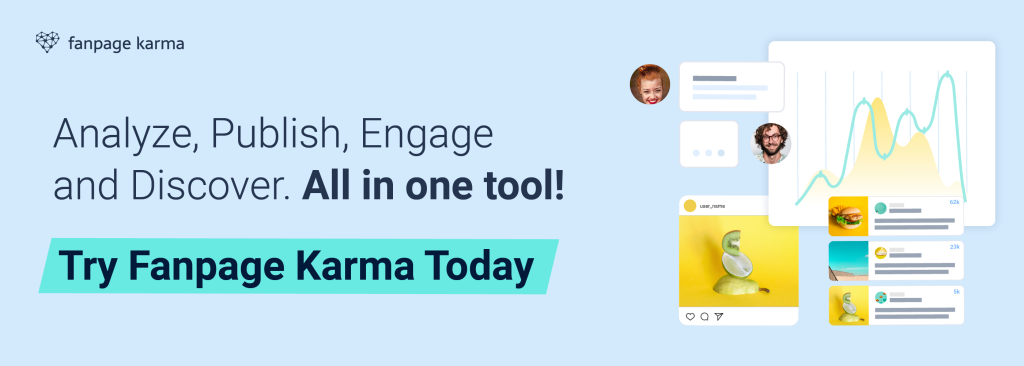
Step 3: Analyzing Twitter Hashtags Data Output
Once you have chosen the profiles you would like to analyze and the timeframe of your analysis, it’s time to study the data output. There are some social media tools on the market that offer advanced hashtag analysis capabilities. These tools allow you to closely study various metrics associated with hashtags in your industry or niche.
In order to help illustrate the usefulness of these tools, we are going to provide a concrete example of the various ways you can analyze your data. As we mentioned above, we will be using Fanpage Karma to analyze hashtags used in an industry, as well as illustrate how to understand your data. We will focus mainly on discovering what hashtags correspond to high post interaction rate, but we will also discuss some other metrics as well.
First, let’s look at the different data output presentations you can choose from for your analysis. For our airlines example, we will first look at what hashtags we should consider using based on data for November 2023. In this first example, we will focus on all airlines in our data set, which is split between US and European carriers.
The first view we will highlight is a hashtag chart that displays hashtags by their frequency of use and their relative post interaction rate for the given time period. In this chart, a larger word means that the hashtag was used more often, while greener words are ones with a higher relative post interaction rate. The advantage of this view is that you can not only see how often a hashtag was used, but also see what hashtags have a good post interaction rate.
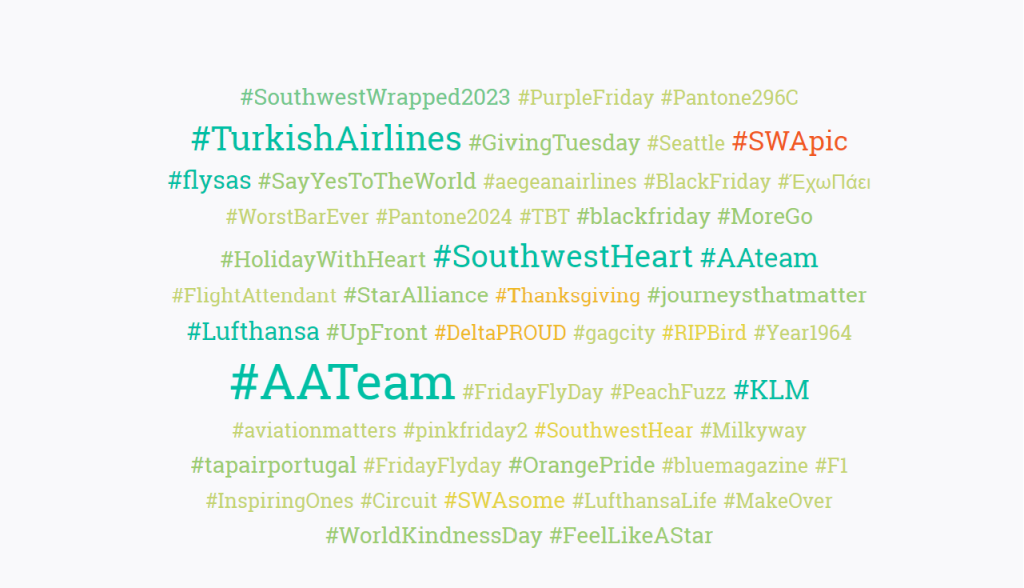
(November 2023)
Another possibility is to simply look at the post interaction rates associated with hashtags used in a given time period by the profiles you are tracking. Below, a bar graph is used to show the top 10 hashtags in terms of post interaction rate in a given time period (in this case November 2023). This bar graph can be adjusted to see as many hashtags as you want, whether it is 10, 20, or more. The advantage of this view is that you can study the post interaction rates of individual hashtags closely.
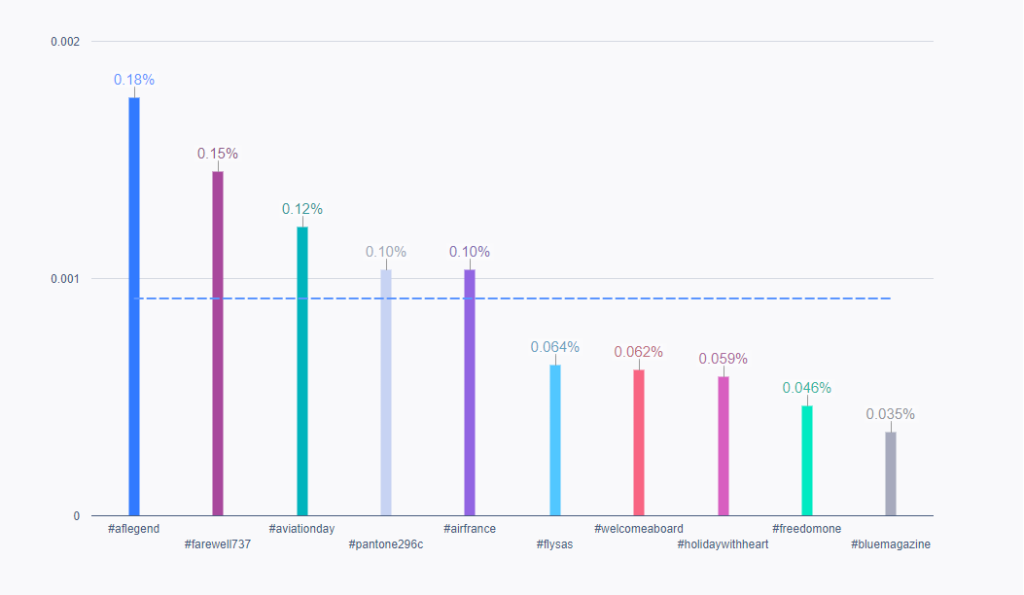
(November 2023)
Studying Twitter hashtag statistics on a broad basis can help you understand various metrics associated with individual hashtags. With Fanpage Karma, you can also create a metric table that displays all the hashtags you used in relation to a variety of metrics, in this case: post interaction rate, posts per day, and interactions per impression. By studying a table such as the one displayed below, you can get a more granular view of how individual hashtags perform in a given timeframe.
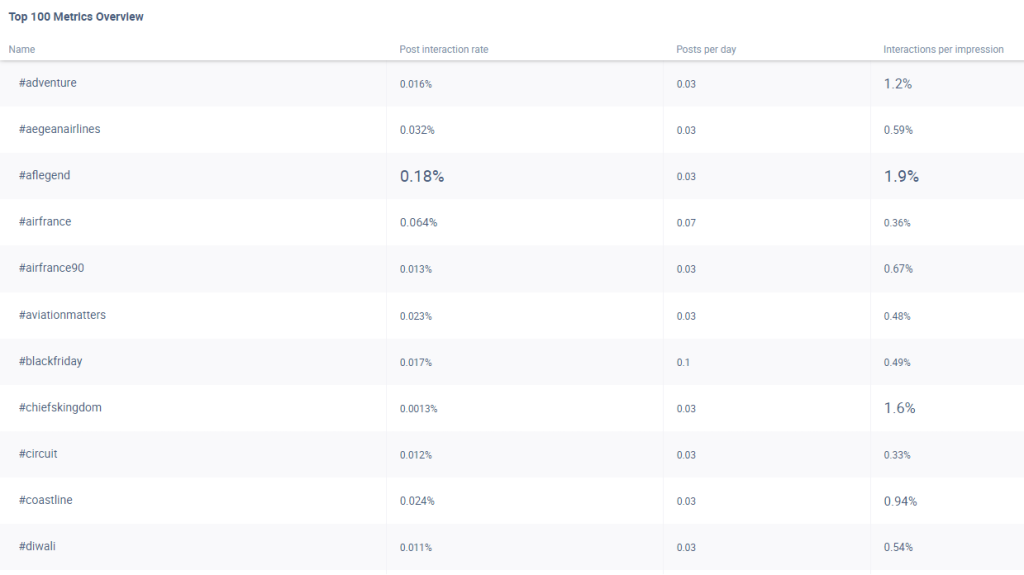
(November 2023)
These three views show you the different ways you can study Twitter hashtags to find out what ones you should consider using in your own Tweets. However, as we already detailed above, various changes to the size or focus of the profiles you track can alter your data set and give you new understandings of your data.
Let’s look at the various changes in data if we specify a specific market we are interested in. As we detailed above, we are looking a various European and American carriers. However, what would happen to the data output if we analyze hashtags on a market-specific basis rather than pooling all these profiles? The first bar chart will look at the top 10 hashtags with regard to post interaction rate for just European carriers.
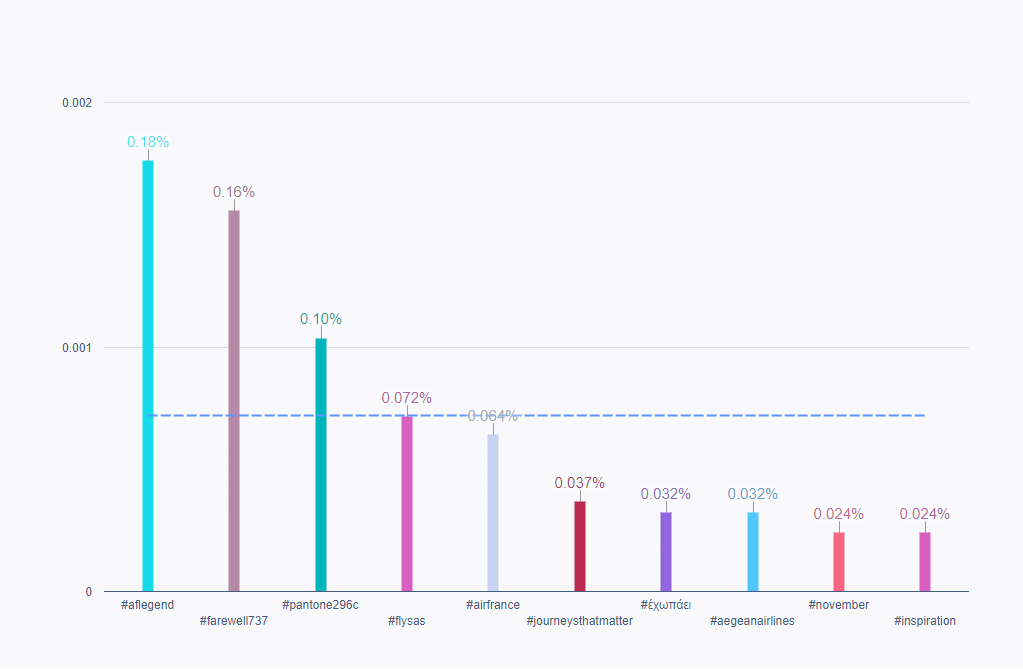
(November 2023, European Carriers)
Now, let’s restrict the profiles we are analyzing only to US carriers.
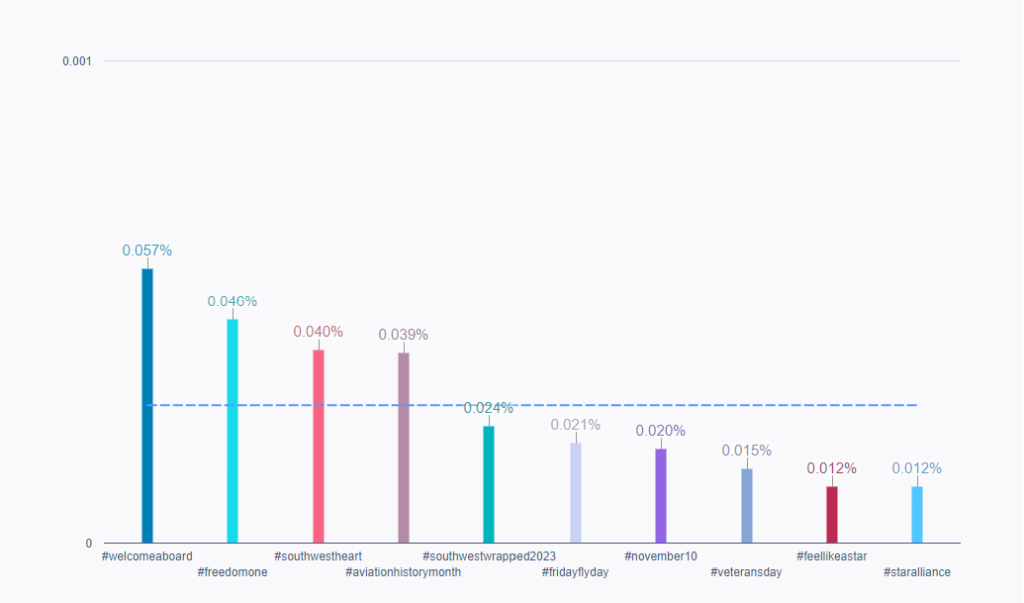
(November 2023, US Carriers)
As you can see from this comparison, the various hashtags that you may consider using may change according to whether you are focusing on a specific market or grouping markets together. Depending on your company goals, you may consider grouping profiles together during your analysis and/or looking at it with a market-specific approach.
One last way we can look at our data is related to the specific time of the year you are interested in. Remember that above we distinguished between a general or a specific approach. For our profiles we are tracking across the US and European markets, let’s look at the various data outputs we would have if we analyzed the top profiles for a half year, or for a specific period, in this case December.
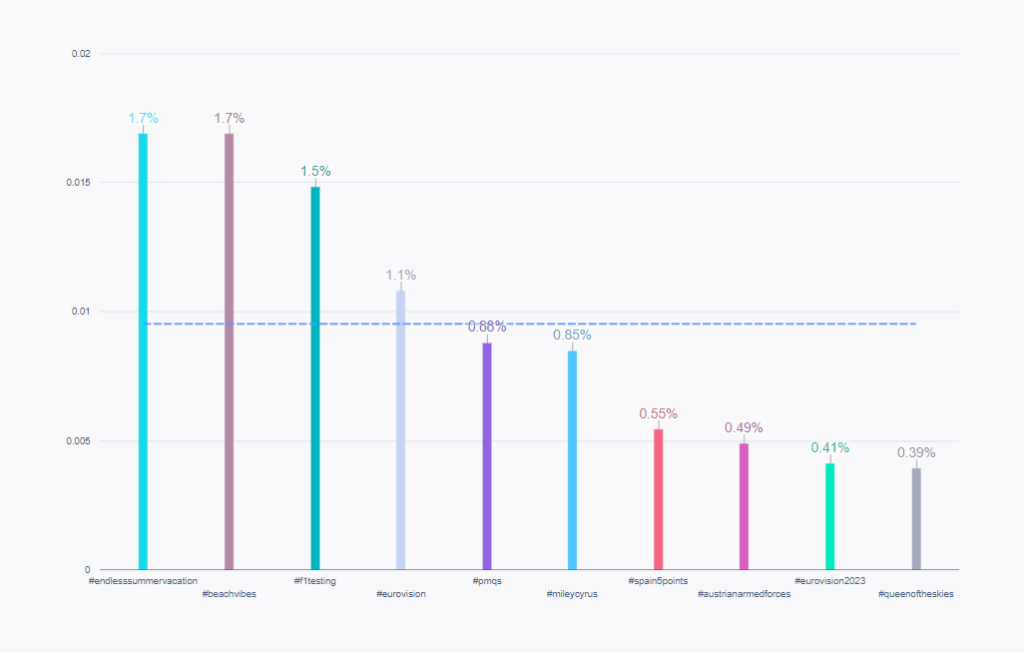
(First-Half 2023)
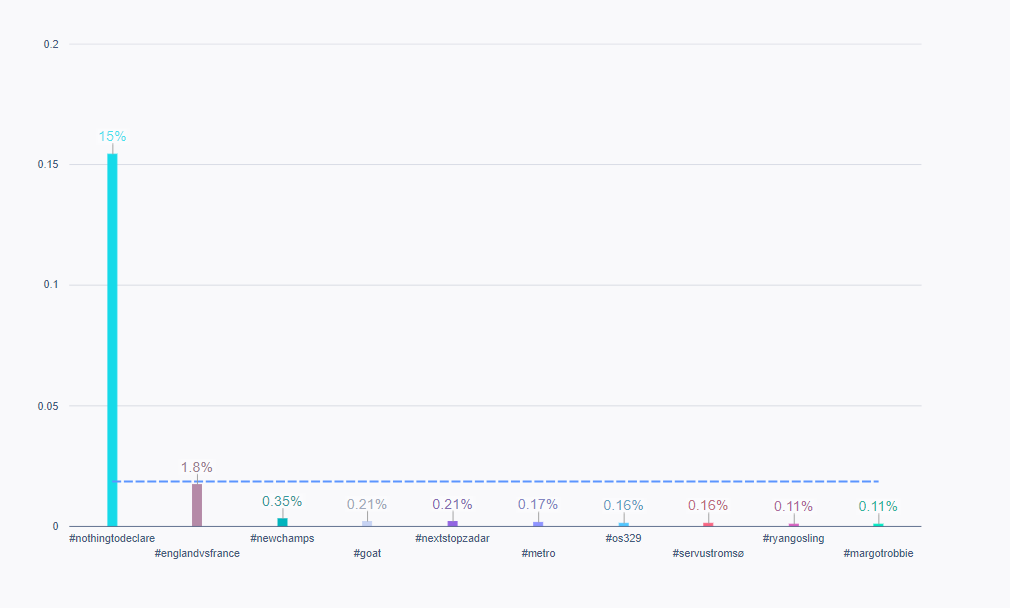
(December 2022)
For the general approach, you get a good understanding of what types of hashtags you should consider using for the second half of 2023 by looking at the first half of the year. For the time specific approach (December 2022), you can better understand which ones you should consider using during December of the next year, which can be valuable if you are running a Christmas campaign and want to use relevant hashtags.
When conducting your research, it is important that you analyze Twitter hashtags carefully to understand which ones you should consider using in your posts. Always ask yourself what hashtags are relevant and which ones make sense to use with specific posts in your content plan.
Step 4: Implement and Monitor
Once you identify the hashtags that correspond with high post interaction rates, make sure that you include them in your content creation plans! While hashtags shouldn’t be the defining factor in deciding what to tweet about, they should complement your Tweets. They can also give you a good idea about what type of topics you should tweet about in general.
Importantly, you should always be sure to monitor your Twitter hashtag statistics and adjust your strategy accordingly. The use of hashtags is not static, and changes in what hashtags you are using or what is working may come quickly. With many social media tools, you can also benchmark your performance against that of your competitors. This is a helpful feature to see how you are progressing with regard to rising the post interaction rate of your Tweets vis-à-vis your competitors.
Conclusion: The Value of Hashtag Research for Twitter
As we have covered above, hashtag research does not depend on simply a “gut feeling.” Rather, you should use data to your advantage and find out what hashtags correlate with a high post interaction rate. This can go a long way in helping you grow your follower count while reaching new audiences.
If you want to conduct the type of Twitter hashtag research we have shown above, you can take advantage of Fanpage Karma’s free 14-day trial. Fanpage Karma is an all-in-one social media tool that provides powerful analytical insights while also offering benchmarking, community management, publishing, and research features.
Moreover, if you want to learn how a social media tool can improve your social media performance, you can participate in Fanpage Karma’s free weekly webinar.









